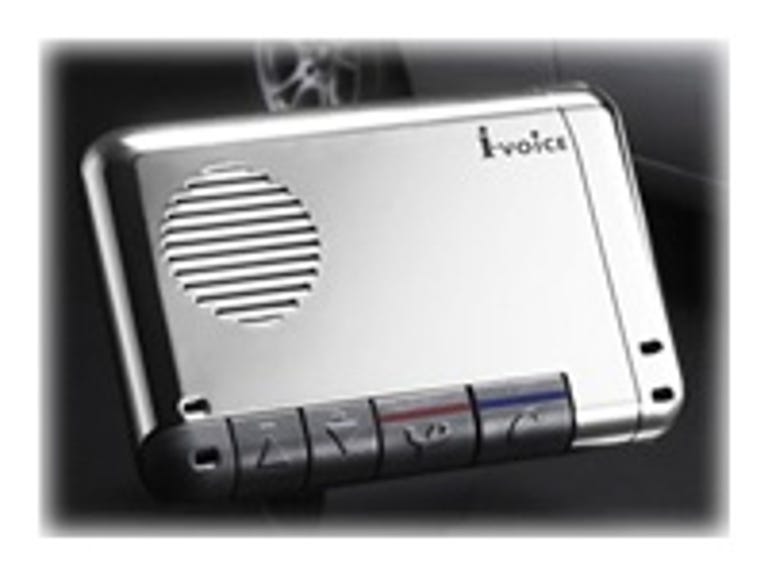 Why You Can Trust CNET
Why You Can Trust CNET iVoice R1 Bluetooth Hands Free Speakerphone Car Kit review: iVoice R1 Bluetooth Hands Free Speakerphone Car Kit
iVoice R1 Bluetooth Hands Free Speakerphone Car Kit
The iVoice R1 Bluetooth hands-free kit appears to be a fairly basic wireless speakerphone. In the box, you'll find 120V and 12V USB charging adapters, a rather short Micro-USB to USB cable, a visor clip, the user guide, and, of course, the R1 unit.
The Good
The Bad
The Bottom Line
Design
The R1 unit measures 4 inches wide by 2.75 inches tall and is a hair larger than 0.25 inches deep with the visor clip removed, or about the size of a deck of cards, and is easily tucked into a shirt or pants pocket. The unit is available in black or red, but our tester featured a screen-printed carbon fiber pattern that made the unit look, well, cheap.
The top of the unit is home to a 1-inch speaker that actually gets quite loud. Along the bottom edge are four buttons for volume up, volume down, ending, and answering calls. The end call button is inset with a red power indicator LED and the answer button holds a blue Bluetooth status LED. Located at the R1's lower corners are two directional microphones that feature two reception modes that will be discussed later.
The system is designed for use in a car and the beefy removable visor clip does a good job of keeping the unit steady during spirited driving.
The R1's rechargeable battery gets its power from a Micro-USB port on the device's top edge. The battery is not user serviceable or removable. The R1's included Micro-USB to USB charging cable isn't long enough to allow the R1 to be used comfortably while connected to a power source, but the claimed 30 hour talk time and 800 hour standby time should be enough to get through a week of use.
Features
The R1 is a Bluetooth V2.1+EDR class device that pairs with a mobile phone using a four digit PIN. The R1 is able to remember pairings for up to eight handsets and can be paired with two phones simultaneously, with a feature called multipoint pairing. With two phones paired, the R1 can answer incoming calls from either handset, but can only handle one call at a time.
Once connected, the R1 has the capability to access most phones' voice dialing features, but lacks the capability to do so on its own. The R1 also doesn't import your contacts, assign voice tags, or offer any sort of manual dialing option beyond a simple last call redial function, putting the unit at a distinct usability disadvantage to devices like the Parrot Minikit Slim.
Unlike our current Editors' Choice headset, the Motorola Motorokr T505, the R1 is a voice-only device and does not support A2DP stereo audio streaming. However, it does have an extra trick up its sleeve, a dual-mode microphone array.
The default mode is a noise-cancellation mode that uses a single microphone to pick up dialog in a narrow 90-degree cone, while the second microphone listens for background noise and echoes to filter out. This mode is best for noisy environments, such as the driver's seat of a moving vehicle, where the R1 does a great job of filtering out road and wind noise while leaving dialog clear.
The second mode is accessed by holding the answer and end buttons during an active call (being careful not to hang up) to enter conference mode. Conference mode uses both microphones to expand the unit's sensitivity to a 360-degree cone, better suited to picking up multiple speakers. This mode sacrifices some of the noise- and echo-cancellation, making it best suited for quiet, indoor environments. However, the more sensitive microphones mean that the R1 can be tossed onto the center of a table for impromptu conference calls.
Performance
Lacking a screen and only having four buttons to work with means that the R1 uses key combinations to access higher-level functions beyond simply answering calls and tweaking the volume. However, these key combinations aren't always the most intuitive. Adding complexity, many of the commands can only be accessed when the speakerphone is in a certain mode.
For example, to turn off the flashing Bluetooth indicator for nighttime driving, the unit must be put into standby (which means unpairing your phone), then double tap the volume up button. To pair an additional phone, the volume up button is held with the unit in standby until the unit speaks a four digit PIN. Most heinously, to check the battery level you must first turn the unit off. Then hold both volume buttons to make the power indicator LED flash. One flash is 20 percent charged up to five flashes for 100 percent. That's far too many steps and far too much counting and math just to check the battery!
In sum
Ultimately, there is much to like about the iVoice R1's performance, but just as much to dislike about its interface.
We love the long battery life that won't leave us stranded without a charge and the slim, pocketable design--but we would skip the faux-carbon fiber look. However, the unit loses points for an overly simple interface that makes the user jump through overly complex hoops to change the settings. We're just not fans of memorizing key combinations or carrying around instruction manuals.
To be fair, once you have the R1 set up to your liking, you could just leave it there and not bother with the medieval settings. Most importantly, in the category that really counts--call quality--the R1 is second only to our Editors' Choice T505 thanks to its two-mode, dual-mic array.


